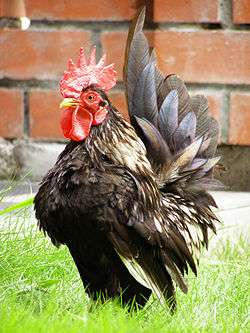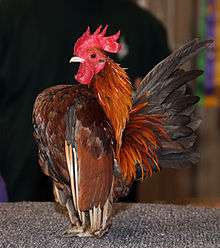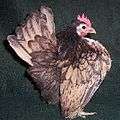Serama
The Serama (Malay: Ayam Serama), also called the Malaysian Serama, is a bantam breed of chicken originating in Malaysia within the last 50 years.

History
Serama originate in the Malaysian state of Kelantan, apparently through the crossing of Japanese and Malaysian bantams. Other stories of the birds derived from a gift of some small chickens by the King of Thailand to a local sultan in ancient times. Small chickens have always been popular pets in this area and are often referred to as "ayam katik" (pygmy chickens) and "ayam cantik" (pretty chickens).
The modern breed is attributed to the efforts of Wee Yean Een from Kelantan, who named the breed "Serama" after Rama, the title of the Kings of Thailand. The breed was first exhibited in 1990. The breed was hit hard by the Asian bird flu epidemic in 2004 when many birds were culled amid government concerns.
There are no written standards for the breed in its native country. However, they do now have an overall guide on scoring and judging for competitions in Malaysia. Many breeders have a style or type that they breed to, but often breeders keep several "styles". These styles are often names given by breeders to describe a blood line of a champion (e.g. Husin, Mat Awang), but may also be more general shape, characteristics or behaviour (e.g. slim, submarine, and dragon). Hence there is quite a lot of diversity in Malaysia, but an overall theme of a small brave chicken with a persona of fearless warrior or toy soldier. The shape, behaviour, temperament and size of the bird are the most important characteristics. They compete against each other in open table top competitions (often described as "beauty contests") and scored by several judges. The prize for the winning birds can be quite a bit of money.
United States

The Serama is promoted by several organizations in the U.S. One is known as "The Serama Council of North America".[1] This council helped to introduce the Serama to North America in various National Poultry shows. In the spring of 2004 a Serama-only show, known as the Cajun Classic, was held in Baton Rouge, Louisiana. The American Serama as put forth by the Serama Council of North America has now gained acceptance by the American Poultry Association and the American Bantam Association as of April 2011 with the White color variety being the first to be accepted.
Color Variety Acceptance
In November 2017, a number of Serama fanciers were brought together by longtime breeder Josiah Woodfield to attempt a qualifying meet for the black and exchequer varieties of Serama. Following this meet, in January 2018, the black variety was accepted by the ABA. The Exchequer variety was later accepted following a 2nd qualifying meet at the Ohio Nationals in fall 2018. More meets are currently being planned by SCNA along with members of several other organizations to petition ABA for acceptance of Blue, Splash, Wheaten, Chocolate, & Cuckoo varieties.
Other Serama Clubs in US
In early 2012, a group of fanciers splintered from SCNA to form their own organization. Their purpose is to bring together breeders and exhibitors of American Serama in the US. They claim to have sanctioning authority for tabletop shows and offer a master breeder points system, not unlike that used by SCNA. This group is known as the American Serama Association.[2]
In more recent times, a third group known as Serama-USA as formed to promote the more extreme styles of Serama as found in their home country of Malaysia since the bird flu. Serama-USA has several tabletop shows yearly.[3]
Europe
Seramas were initially imported into the UK in 2004. Birds were imported from both America and directly from Malaysia. The foundation Serama flock in the UK consisted of only a few dozen birds. In 2005, a small group of Serama owners and enthusiast decided to form the "Serama Club of Great Britain", the first Serama club in the UK. They established the standard for the Serama breed for the UK. Eventually in 2008, the club was officially recognized as the affiliated breed club of the "Poultry Club of Great Britain".
Seramas are still relatively rare and expensive in much of mainland Europe. The Netherlands probably has the largest number of Seramas outside the UK. Most of the stock in the Netherlands are descendant from birds/eggs imported from America and from the UK.
In France and other European countries they are increasing in popularity. They have 4 classes of seramas.
General characteristics
The Serama are characterized by their upright posture, full breast, vertical tail feathers held upright and tight up to the body and vertical wings held down nearly touching the ground. In Malaysia they are described as brave warriors and archangel chickens, because of their very human like appearance.
They are the smallest breed of chicken in the world. Typically under 500g, but with even smaller birds that are under 250g being bred in its native Malaysia. However, size alone does not define a Serama. A small chicken without the Serama "type" is not a Serama, but just another small bantam.
The following describes the overall characteristics of "Malaysian type." The Americans and Europeans have defined variants thereof.
Carriage and Temperament
Assertive with confident bold stance yet calm and manageable. Should be easily handled and show no aggression. The bird should pose readily and when viewed from the side should create a vase like or wide ‘V’ shape outline. They shake their wings and pose, walk with pride, pull their head back to reveal a large chest, lift the legs, and in some styles have neck/head vibrations similar to that of a pigeon.
Body
The body is well muscled with breast carried high, full and well forward. From above the shape is somewhat elliptical, tapering towards the tail. The body should be short.
Wings
Fairly large wings in proportion to the body they should be held in a vertical position just clearing the ground and leaving the feet partially visible. Shoulders should be set high on the bird. Primaries are long of medium width with secondaries moderately long and broad.
Tail
Tail is full and carried high, pointing upwards and held close to the body of the bird with no space between the body and tail. The sickle feathers are relatively straight and spear like. A minimum of one inch longer than the other tail feathers, but ideally no more than a couple of inches above the head is desirable. The remaining tail feathers should ideally be no higher than the top of the comb when the bird is standing to attention. The Main tail feathers should be broad and should over lap neatly. The tail should be open and when viewed from behind should be open to an angle of 45 degrees creating an open ‘V’ shape.
Head
Head should be small and carried well back. Head is required beyond the level of the feet and held in position of more than 90 degrees from the feet. The single comb is small to medium in size with a minimum of five serrations preferred. The comb should be straight smooth, free of folds or any deformities and tending towards flyaway type. Wattles are to complement the comb, smaller being preferred and free from folds and wrinkles.
Legs and feet
The legs are of medium to long length, straight and set wide apart to allow for full and muscular body. They should be strong and stable. Thighs should be of medium length and well muscled with shanks of good thickness. They should not appear soft and weak.
Feathers & Color
Like some other Asiatic breeds, they are not color bred in their native country. Only normal feathered birds are accepted in Malaysia. Feathers held tight against the body and should not be long or flowing.
Silkied feathered birds are accepted in America and much of Europe. The silkied gene was believed to be carried by some birds imported from Malaysia.
Other mutations (e.g. frizzled, rumpless and booted) have been introduced in America and some parts of Europe by crossing to other breeds. They can have a range of varieties in color and structure.
Breeding types
AMERICAN SERAMA
ABA recognized colors, shown in ABA/APA in cage competition Disqualifications, include weights above our under weights listed above, shank colors other than yellow or swarthy and white earlobes.
TRADITIONAL SERAMA All colors accepted, these are shown in Table Top competition No Disqualification, neither feather, shank or earlobe.
Sizes – Cocks, Micro – up to 13 ounces Class A – under 13 ounces Class B – under 16 ounces Class C – under 19 ounces
Hens Micro – up to 8 ounces Class A – under 12 ounces Class B – under 15 ounces Class C – under 17 ounces
Micros are a novelty only and guaranteed not to reproduce Class A – too are virtually useless. They do not have the musculature to give them the full-bodied type required per standard and rarely are they viable or good layers. Class B - anyone interested in breeding the SERAMA would settle for the B Class. These are guaranteed to breed and reproduce ot will be replaced for the cost of shipping. B's can and do give Micro and A Class offspring. Class C – C class are excellent breeders capable of giving B offspring and smaller.
Any Cock over 19 ounces or Hens over 17 ounces are considered culls, because of weight.
MALAYSIAN (AYAM) SERAMA These are the extreme types. They have no color nor weight disqualifications and are used for Table Top Competitions only.[4]
Breeding
Seramas are much like other Bantam breeds. After laying an egg it takes around 19 days for the chicks to develop and hatch. Chicks are more susceptible to cold temperatures compared to other breeds because of their relative small size. After hatching, it takes about 16–18 weeks for the chicks to mature and reach the point at which they themselves can begin laying eggs.
One U.S. breeder of note was Mr. Brian Sparks of Wisconsin. Mr. Sparks advocated the Malaysian style of breeding. He was successful in recreating the strong type and small size seen in true Malaysian birds. Word got back to the serama's native country and top breeders. They took interest in his work and articles about his successes were published by Malaysian news sources.[5]
Gallery
References
- "Serama Council of North America".
- "American Serama Association".
- "Serama-USA Club".
- https://jerrysseramasllc.weebly.com/availability.html
- "Rela Berhabis Duit Kerana Minat Ayam Serama". Department of Veterinary Services, Perak, Malaysia.
- Wright, Carrie (2009). An Introduction to the Serama Bantam. Seeright Publishing. ISBN 978-0-9562255-0-4.
- Ekarius, Carol (2007). Storey's Illustrated Guide to Poultry Breeds. Storey Publishing. ISBN 978-1-58017-667-5.
- Henderson, Jennifer (March 30, 2009). "Malaysia's mini-chickens big it up after flu scare". Reuters.


